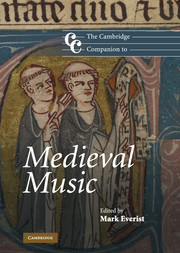Book contents
- Frontmatter
- Introduction
- Part I Repertory, styles and techniques
- Part II Topography
- Part III Themes, topics and trajectories
- 11 Music and liturgy
- 12 Vernacular poetry and music
- 13 Latin poetry and music
- 14 Compositional trajectories
- 15 Ecclesiastical foundations and secular institutions
- 16 Theory and notation
- 17 Music manuscripts
- 18 The geography of medieval music
- 19 Reception
- Notes
- Bibliography
- Index
16 - Theory and notation
from Part III - Themes, topics and trajectories
Published online by Cambridge University Press: 28 September 2011
- Frontmatter
- Introduction
- Part I Repertory, styles and techniques
- Part II Topography
- Part III Themes, topics and trajectories
- 11 Music and liturgy
- 12 Vernacular poetry and music
- 13 Latin poetry and music
- 14 Compositional trajectories
- 15 Ecclesiastical foundations and secular institutions
- 16 Theory and notation
- 17 Music manuscripts
- 18 The geography of medieval music
- 19 Reception
- Notes
- Bibliography
- Index
Summary
An overview of medieval theory involves three primary content areas: pitch, rhythm and counterpoint. Two far-reaching concerns of medieval theory surface time and again in this overview: early theorists continually attempted to understand an inherited repertory, chant, in terms of an evolving theory, and they tried to bring their own theory into congruence with venerated ancient Greek theory. Not unrelated, the writers searched for a satisfactory notation, both letters and music symbols, to transmit their repertory and theory about it. As we read these theorists' exposés, differences emerge in how they formulate and present their ideas. With respect to audience, teaching in the Middle Ages shifted increasingly from monastic settings to cathedral school and university settings. We also witness certain differences in genre presentation, including dialogues and compendia. Finally, it is useful to think of early theoretical writings in terms of categories set up by Claude Palisca: precompositional, compositional, executive (performance) and critical. That is, theorists could engage in theory largely for its own sake, prescribe how to compose and perform, and describe/critique the music they were hearing in their respective societies.
Early Middle Ages
The writer who unquestionably exerted the greatest influence on medieval theorists was Boethius (AD 480–524). In De institutione musica, one of four treatises he devoted to the quadrivium or the four mathematical disciplines, Boethius foregrounded an understanding of music in terms of numerical ratios: he interpreted musical intervals as consonant or dissonant in accordance with the simplicity of their ratios. Through Boethius the emphasis on unison, octave, fifth and fourth as perfect consonances entered the consciousness of the medieval mind.
- Type
- Chapter
- Information
- The Cambridge Companion to Medieval Music , pp. 276 - 290Publisher: Cambridge University PressPrint publication year: 2011
- 2
- Cited by

